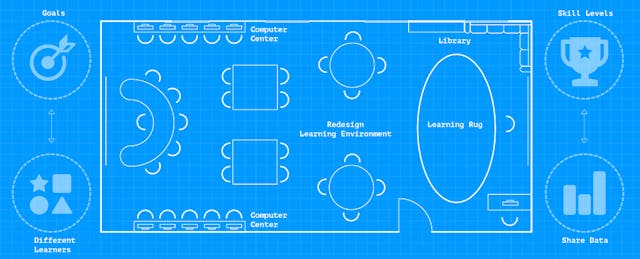As student-centered learning gains momentum in the American classroom, some education leaders are making the mistake of pushing change too quickly. Indeed, it’s rare to find a school system that fully grasps the assumptions and habits critical to success in the student-centered learning environment—let alone one that gives its teachers adequate time to prepare for the change.
But it’s not just teachers who need to change: Students, too, must undergo an adjustment.
For instance, students have to learn how to take ownership of their learning. They must be comfortable in the knowledge that everyone learns differently, and they must learn how to become advocates for themselves. Only then will student-centered learning be effective.
With that in mind, here are five steps to establishing a student-centered learning culture among your students:
1. Share assessment data with them.
Assessment results often are shared only with parents or among teachers, but a key to having students take ownership of their learning is making sure that students understand where they are in the learning continuum—and where they need to progress in order to be proficient.
“Teachers should be sitting down with their students and saying, ‘Here’s where you are, and here’s where we need to get you,’” said Rachael Turner, Transformation Manager for School Improvement Network.
2. Have students write their own goals.
Once students understand what they need to do to become proficient, you can discuss a plan for helping them get to that point together.
Turner suggests starting with one content area at first, and then gradually establishing goals for other content areas as well. “Students can chart their progress toward these goals,” she said. “By writing individual goals, students can celebrate each other’s successes. And by starting with one goal, students can feel success quickly—while also seeing that not everyone has the same goal.”
3. Instill the message that everyone is different.
In a successful student-centered learning environment, students understand that not everyone learns at the same rate or in the same way, and they respect each others’ differences.
That’s a key message that must be imparted by everyone throughout the school or district, Turner said—and it must become a cornerstone of the school or district culture.
4. Rethink how you define skill levels.
Replacing grade-level descriptions with a different scale when describing student objectives can help remove the stigma associated with working below grade level, Turner said. So, if a fourth-grade student is working at a fifth-grade level in math but only a third-grade level in reading, you might say she’s at a “level 8” in reading but a “level 12” in math.
“When we strip away those grade levels, we take away the stigma,” Turner said, calling this a “powerful” practice. Instead of feeling inferior because she’s below grade level in reading, the student is more likely to focus on the skills she needs to master to progress to the next level.
5. Redesign learning environments to reflect this change.
Research suggests that the design of learning spaces has a lot to do with establishing the culture of a school. If you’re looking to create a student-centered learning culture, it makes sense to rethink what your classrooms look like to better reflect this change.
Are the desks and chairs arranged in traditional rows, or are they arranged in groups that facilitate student collaboration? Better yet, are the desks gone entirely? Some schools have shaken up the traditional classroom structure by importing couches and creating centers designed for various kinds of work, Turner said—like a student union at a college or university might look.



